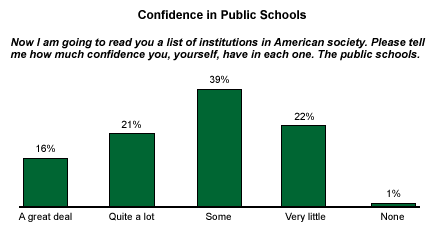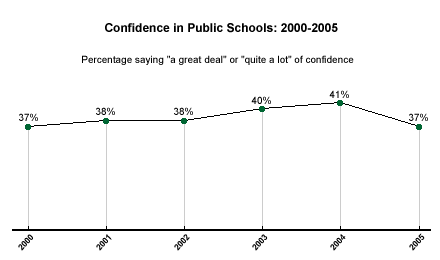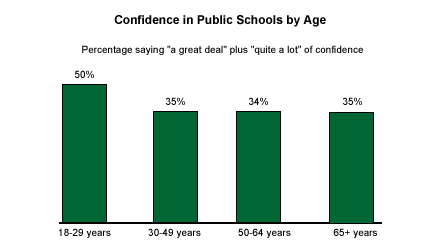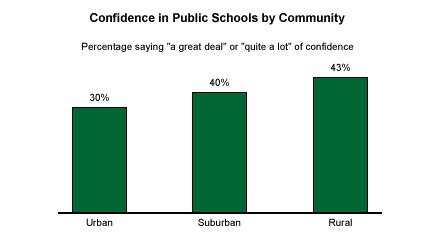Most American parents send their children to public schools, yet just 4 in 10 U.S. adults express a high degree of confidence in this time-honored institution. According to Gallup's latest "confidence in institutions" poll*, 37% of Americans say they have "a great deal" or "quite a lot" of confidence in public education; 39% have "some" confidence and 23% have "very little" or "none" at all.
At 37%, the public schools rank in the middle of the list of 15 institutions Gallup measured, just below the Supreme Court, but ahead of the television news media. (For the complete list, see "Military Again Tops 'Confidence in Institutions' List" in Related Items.)

Necessary Education Reforms
The last year that even a slight majority of Americans (53%) told Gallup they had either a great deal or quite a lot of confidence in the public schools was 1979. Since then, less than 50% of Americans have been that confident. The public's confidence level has been relatively stable at around 40% since the early 1990s, after being in the mid-to-high 40s during the 1980s.
By the time President George W. Bush signed No Child Left Behind (NCLB) into law, there was already considerable demand placed on the education community to improve school performance. This pressure stemmed from many problems, including American students' relatively low scores on internationally benchmarked tests, a persistent racial gap in almost every measure of educational attainment, and a wide gulf in the quality of education between urban and suburban schools. But despite the many new initiatives NCLB required and some reported progress, public confidence has not increased since the law was enacted in January 2002.

Demographic Differences
Ratings show little variation by gender, level of education, religious preference, income level, political ideology, race, or those with children under age 18. But some variations do emerge by age. Young adults (aged 18 to 29), who may have the freshest memories of their own public school experiences, have a somewhat higher level of confidence than older Americans do.

Community Matters
Urban schools, with a higher proportion of low-income, racially diverse students, have lagged behind suburban and rural schools in performance measures, and consequently the data show a significant gap in high confidence between urban respondents and rural respondents -- 30% compared with 43%, respectively. Suburbanites fall in between, at 40%.

The leaders of public education in the United States have shown a closer alliance with the Democratic Party than the Republican Party in American politics. Gallup's polling shows those that identify as Democrats are consistently more likely to express confidence in the public schools than are Republicans or independents. In this year's poll, 42% of Democrats say they have a high degree of confidence in public schools, compared with 36% of Republicans and 35% of independents.
Bottom Line
Technology has advanced with the speed of light in the last decade, putting the United States in a global competition never before imagined. In his new book, The World Is Flat: A Brief History of the Twenty-First Century, Thomas Friedman quotes a warning from Microsoft chairman Bill Gates: "By 12th grade, U.S. students are scoring near the bottom of all industrialized nations … In the international competition to have the biggest and best supply of knowledge workers, America is falling behind." If Gates is correct, the U.S. public schools have their work cut out for them in the coming years.
*These results are based on telephone interviews with a randomly selected national sample of 1,004 adults, aged 18 and older, conducted May 23-26, 2005. For results based on this sample, one can say with 95% confidence that the maximum error attributable to sampling and other random effects is ±3 percentage points. In addition to sampling error, question wording and practical difficulties in conducting surveys can introduce error or bias into the findings of public opinion polls.